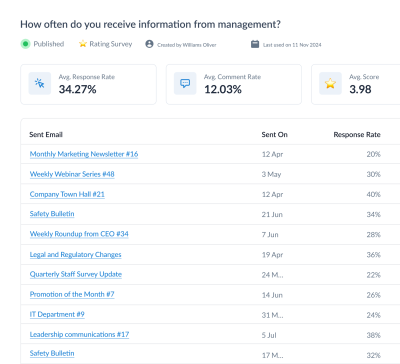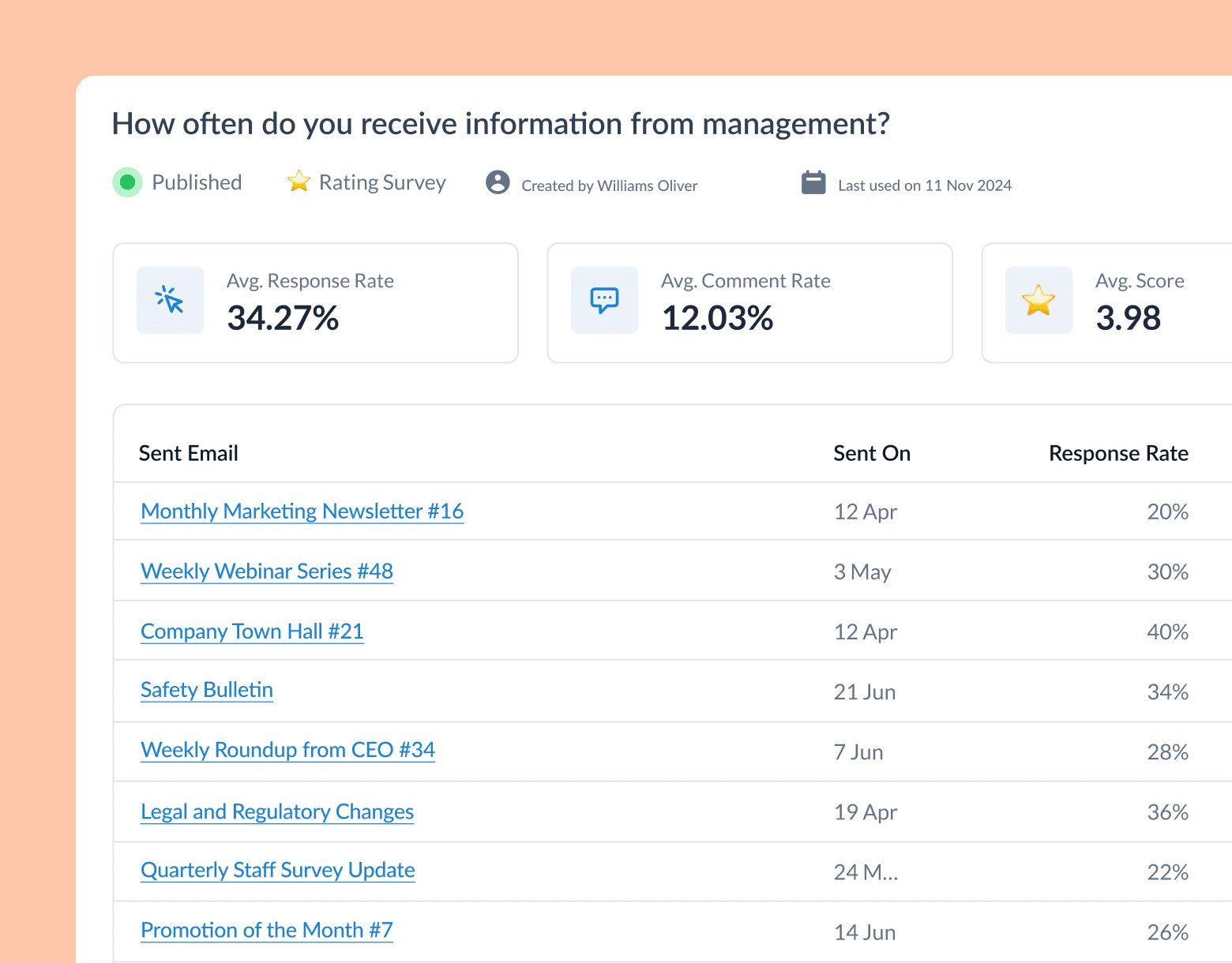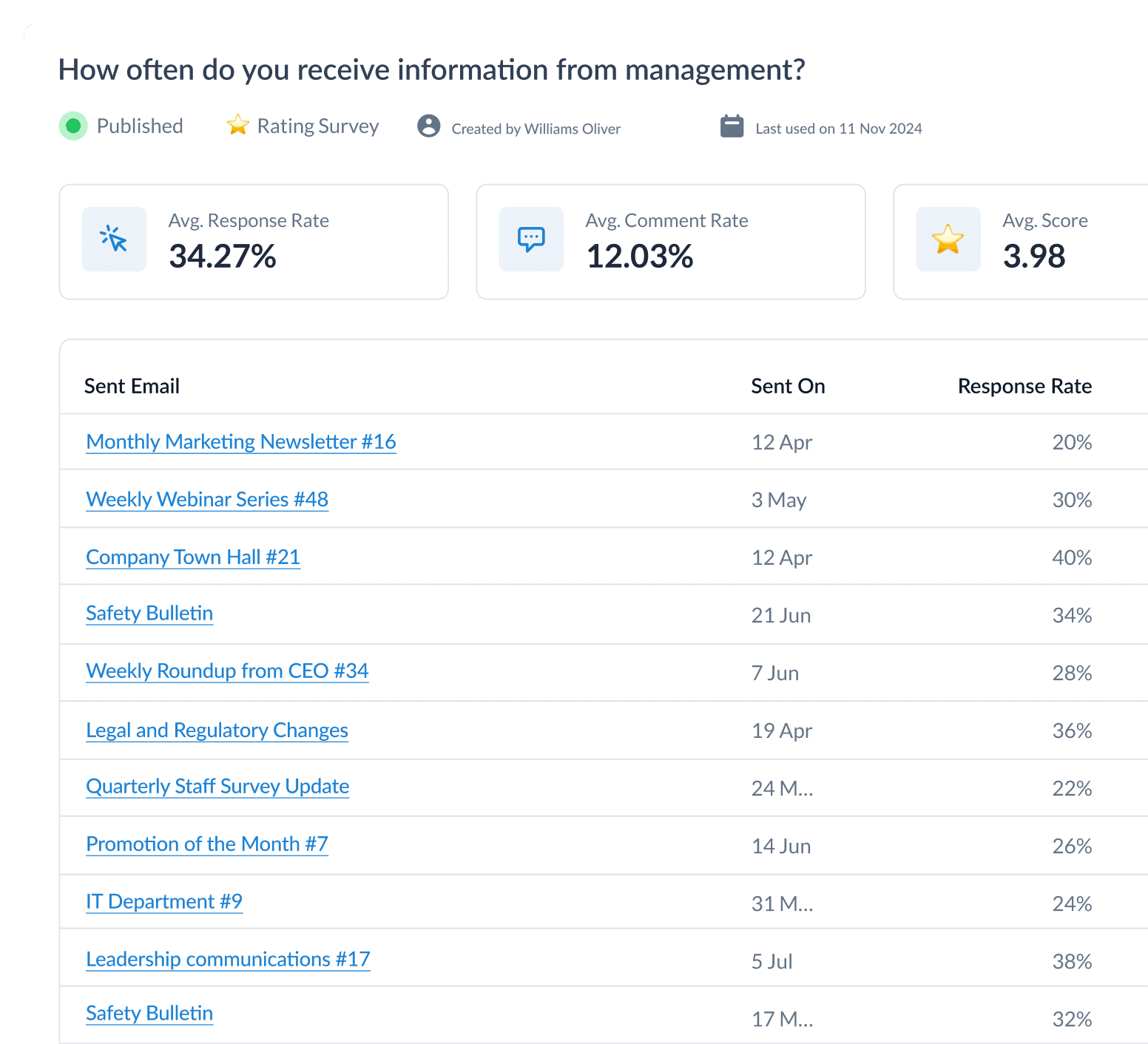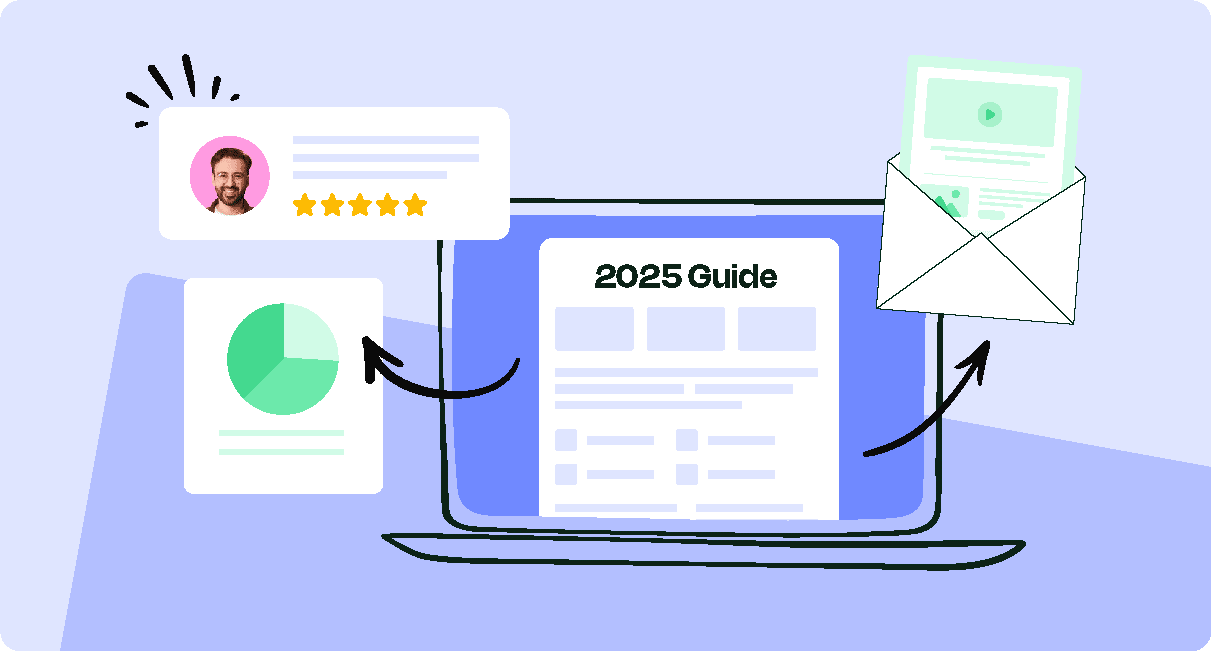If you’re wondering why employee engagement is important, you’re already asking the right question. Because in 2025, the companies winning aren’t just the ones with the best tech or biggest budgets—they’re the ones where employees genuinely care. Read on to understand just how important employee engagement is in 2025.
So, what is employee engagement, and why is it important? At its core, employee engagement is the emotional commitment a worker has to their job, their team, and the company. And in the age of hybrid burnout, AI and economic uncertainty, and constant change, that emotional commitment is the glue holding modern workplaces together.
Disengagement isn’t just a vibe—it’s expensive. Gallup estimates disengaged employees cost the global economy $8.8 trillion in lost productivity—that’s trillion with a T.
So, let’s dig into the importance of employee engagement—and the 10 clear, measurable reasons why you should care more than ever.
Take a self-guided tour of ContactMonkey
See how our key features can streamline your internal communications.
Take product tour

Why Is Employee Engagement Important in 2025?
Employee engagement is important in 2025 because it directly impacts retention, productivity, well-being, and business success. Engaged employees are more committed, motivated, and aligned with company goals—making them more likely to stay, perform, and contribute meaningfully.
As the workplace evolves with hybrid work, economic uncertainty, and shifting employee expectations, organizations can no longer afford to treat engagement as optional. Today’s employees want to feel seen, heard, and supported—not just managed.
The main goals of employee engagement in 2025 include:
- Aligning employees with a shared purpose.
- Supporting individual growth and well-being.
- Fostering connection, communication, and culture.
The result? Stronger retention, better performance, and a workplace people don’t want to flee at 4:59 p.m.
Top 10 Benefits of Improving Employee Engagement
Below are the top 10 proven benefits of improving employee engagement—and why every organization should make it a strategic priority in 2025.
1. Boost employee retention and reduce costly turnover
Engaged employees are more likely to stick around. They feel emotionally connected to the company, believe in its mission, and see a future for themselves within the organization.
Why it matters: Retention isn’t just about satisfaction—it’s about emotional investment. The importance of employee engagement becomes crystal clear when you realize how costly it is to lose great talent. In 2025’s volatile job market, employee engagement could be the difference between a thriving team and a revolving door.
How to track this employee engagement benefit:
- Monitor your voluntary turnover rate on a quarterly basis.
- Include “I see a future for myself at this company” in your employee engagement survey.
- Track exit interview themes and compare them against pulse survey insights.
How internal communicators can support this:
- Build automated email journeys for new hires to reinforce connection in the first 90 days.
- Regularly communicate internal mobility opportunities and promotions.
- Share employee success stories and recognize loyalty milestones.
PRO TIP: Use ContactMonkey’s Email Template Builder Feature to create and schedule personalized onboarding emails. Embed a quick pulse survey—like “Do you feel a sense of belonging here?”—and use internal email analytics best practices to make the most of the insight. You’ll catch early signs of disengagement before they become resignations.
Start two-way conversations and employee feedback loops
Learn how to engage staff with pulse surveys, content ratings and reactions, custom polls, and more. Ready to send modern emails?
See engagement features

2. Increase productivity through stronger focus and motivation
Engaged employees bring more focus, creativity, and ownership to their work. They don’t just meet expectations—they consistently look for ways to exceed them. When employees understand the “why” behind their tasks, their output becomes more intentional and impactful.
Why it matters: Productivity isn’t just a measure of hours worked—it’s a reflection of energy, clarity, and purpose. One of the clearest indicators explaining why employee engagement is important is how it affects the quality and consistency of work. Engaged teams are less distracted, more collaborative, and better at problem-solving.
How to track this employee engagement benefit:
- Track performance metrics like missed deadlines or project turnaround times.
- Ask questions in your employee engagement survey like “Do you feel empowered to do your best work?”
- Measure content engagement on internal goal-setting or productivity updates.
How internal communicators can support this:
- Reinforce company priorities and OKRs in internal newsletters.
- Spotlight productivity wins from across teams.
- Reduce information overload by segmenting emails by department or role.
PRO TIP: With ContactMonkey, use the List Management Feature to access segmentation and send goal-specific updates to different teams. Track open and click-through rates using employee engagement software, and test which formats drive the most action. Want a pulse check? Add a quick “Was this helpful?” poll to your next productivity-related update.
3. Build a positive workplace culture that employees believe in
A strong culture is built through consistent, intentional communication. Engaged employees contribute to a positive workplace culture, and they’re more likely to support their colleagues, celebrate wins, and speak up when something’s off.
Why it matters: Culture is the invisible hand that guides how employees behave when no one’s watching. And the importance of employee engagement becomes obvious when you consider that disengaged employees often contribute to toxic work environments. Engaged employees, on the other hand, uphold your values and reinforce the kind of workplace you want to build.
How to track this employee engagement benefit:
- Ask “Do you feel like you belong here?” in your employee engagement survey.
- Monitor feedback and participation in company culture initiatives.
- Track sentiment in internal comment boxes or open-ended survey responses.
How internal communicators can support this:
- Share stories that spotlight company values in action.
- Celebrate team rituals, shout-outs, and cultural milestones in newsletters.
- Provide anonymous channels for employee feedback to ensure psychological safety.
PRO TIP: Use ContactMonkey to embed anonymous feedback forms or emoji reactions in your internal emails—no external links required.
Unlock Internal Comms Superpowers
Discover why 10,000+ rely on us. See the internal email and employee newsletter platform in action.
Book demo

4. Spark innovation by encouraging employee ideas and creativity
Engaged employees feel safe to take risks, challenge the status quo, and suggest new ideas. They’re curious, solution-oriented, and motivated to make things better—not just maintain what exists.
Why it matters: Creativity is a competitive advantage. When people care, they contribute. The importance of employee engagement shows up in how often employees speak up in brainstorms, propose new workflows, or lead cross-functional initiatives. Disengaged teams? They play it safe. Engaged teams? They build the future.
How to track this employee engagement benefit:
- Measure participation in innovation programs, ideation sessions, or hackathons.
- Ask questions in your employee engagement survey like: “Do you feel safe sharing new ideas?”
- Track adoption rates of employee-suggested improvements.
How internal communicators can support this:
- Highlight employee-driven innovations in employee newsletters.
- Create recurring “Your Ideas in Action” sections to show impact.
- Share leadership messages that promote psychological safety and experimentation.
PRO TIP: Embed an open comment box in your next email using ContactMonkey’s Feedback Features—invite employees to submit ideas or nominate colleagues who’ve innovated.
5. Deliver better customer experiences with more engaged teams
Your customer experience is only as strong as the people delivering it. Engaged employees take ownership of their roles, show empathy, and go the extra mile to solve problems—because they actually care.
Why it matters: Employees on the frontlines shape your brand. The importance of employee engagement extends beyond internal culture—it directly impacts how customers feel about your company. Disengaged employees hurt service. Engaged employees elevate it.
How to track this employee engagement benefit:
- Track customer satisfaction (CSAT) and NPS alongside internal engagement metrics.
- Survey employees: “Do you feel empowered to help customers succeed?”
- Monitor service team turnover and escalation rates.
How internal communicators can support this:
- Share customer success stories in internal emails to reinforce mission.
- Use segmented messaging to deliver relevant updates to frontline teams.
- Gather feedback from employees about roadblocks impacting service.
Create and send employee surveys for feedback
Engage staff with pulse surveys, eNPS surveys, reusable surveys, custom polls, and more. Ready to send modern emails?
Explore survey features

6. Reduce absenteeism by supporting employee well-being
When employees feel engaged, they’re more likely to show up—physically and mentally. Engagement promotes accountability, motivation, and well-being, reducing the number of missed days.
Why it matters: Unplanned absences cost companies in lost productivity. But more than that, they signal deeper issues—burnout, disconnection, or lack of support.
How to track this employee engagement benefit:
- Monitor absenteeism rates over time by team or department.
- Ask “Do you feel energized to come to work?” in your employee engagement survey.
- Track sick day trends alongside engagement pulse scores.
How internal communicators can support this:
- Reinforce well-being resources and mental health support in emails.
- Normalize asking for help or flagging burnout early.
- Use newsletters to check in and remind employees of time-off policies.
PRO TIP: Schedule recurring well-being check-in emails with ContactMonkey and include emojis or one-click feedback options to gauge energy levels. It’s a fast, frictionless way to flag issues early.
7. Improve employee mental health and overall well-being
Engaged employees are more likely to feel psychologically safe, supported, and energized at work. When people feel heard and cared for, their mental health and satisfaction improve.
Why it matters: The link between engagement and wellness is direct. One reason why employee engagement is important is that it helps prevent burnout, stress-related absences, and even attrition. Healthy people build healthy workplaces.
How to track this employee engagement benefit:
- Ask questions like “How would you rate your work-life balance?” in your employee engagement survey.
- Monitor feedback from well-being check-ins or ERGs.
- Compare usage rates of wellness programs with engagement metrics.
How internal communicators can support this:
- Share mental health resources and reminders frequently.
- Normalize conversations around well-being in leadership comms.
- Embed anonymous wellness check-ins in weekly emails.
8. Navigate change faster with more adaptable, engaged teams
Engaged employees don’t fear change—they embrace it. When they trust leadership and feel connected to company goals, they’re more likely to pivot quickly and stay optimistic.
Why it matters: Change is inevitable. But disengagement makes it painful. The employee engagement importance story becomes urgent during reorgs, tech rollouts, or leadership transitions—when communication either builds confidence or fuels chaos.
How to track this employee engagement benefit:
- Run employee engagement surveys before, during, and after changes.
- Ask “Do you feel equipped to navigate recent changes?”
- Track participation in change-related Q&As or info sessions.
How internal communicators can support this:
- Launch dedicated email campaigns to guide employees through transitions.
- Offer space for feedback and follow-up questions.
- Reinforce stability by spotlighting what’s staying the same.
BONUS: If you’re looking for more insight on internal comms campaigns, leverage our guide on the best internal communication campaign examples.
9. Strengthen relationships between managers and their teams
Engaged employees typically have stronger, more open relationships with their direct managers. There’s mutual trust, regular feedback, and shared understanding of goals.
Why it matters: According to Gallup, managers account for 70% of the variance in team engagement. So, employee engagement is also important because when the manager-employee connection breaks, everything else follows.
How to track this employee engagement benefit:
- Survey employees with: “Does your manager support your growth?”
- Track frequency of 1:1s and team meetings.
- Compare team engagement scores across departments.
How internal communicators can support this:
- Send managers regular comms toolkits with talking points.
- Offer employee newsletter templates to help managers communicate consistently.
- Highlight teams with strong manager feedback culture.
PRO TIP: Create a custom “Manager Digest” email template with ContactMonkey that managers can personalize weekly. Take advantage of this step-by-step to designing engaging internal emails for support!


10. Drive higher profitability through more engaged performance
Engaged employees work smarter. They stay longer, serve customers better, innovate more often, and contribute consistently to team success. When engagement is high, business performance follows.
Why it matters: According to Gallup, companies with highly engaged workforces are 21% more profitable. If you’re still wondering how important employee engagement is, this stat should close the case.
How to track this employee engagement benefit:
- Track performance outcomes like revenue per employee.
- Monitor engagement trends alongside quarterly profit margins.
- Conduct surveys that connect daily work to larger business goals.
How internal communicators can support this:
- Communicate company performance in an accessible, transparent way.
- Celebrate team wins and show how everyone contributes to success.
- Share leadership communication updates that link employee efforts to business impact.
How You Can Power Employee Engagement With ContactMonkey
We get it: in 2025, internal comms teams are being asked to deliver more—more visibility, more engagement, more proof of ROI—with fewer resources. When headcounts are shrinking and budgets are tight, you need tools that don’t just support your work—they amplify it.
ContactMonkey gives internal communicators and HR leaders the power to reach, engage, and understand employees—all without relying on extra headcount or IT bottlenecks. Whether you’re a team of ten or a team of one, our platform helps you scale your efforts with smart automation and real-time analytics.
Here’s how:
- Create engaging, interactive internal emails in minutes. No designers or devs required. Embed polls, pulse surveys, and feedback forms directly into Outlook or Gmail via Integration Features.
- Segment your audience with precision. Target the right message to the right employee based on role, location, or employment type using audience segmentation.
- Automate recurring employee comms with ease. Save hours every week by scheduling onboarding sequences, leadership updates, or policy reminders in advance—so you can stay consistent, even when bandwidth is low.
- Measure employee sentiment instantly. Know who’s opening, clicking, and engaging with your content—and where you might be losing them.
- Prove your impact with performance dashboards. Show leadership how your work influences retention, productivity, and engagement—especially when resources are on the line.
If you’re navigating layoffs, restructures, or shifting exec priorities, you’re not alone. But instead of cutting corners, you can sharpen your strategy with tools built specifically for internal communications.
In a world where headcount is tight, ContactMonkey helps you scale like a team twice your size. Ready to check out the platform? Book a free 15-minute call with our experts to see how you can elevate your employee engagement this year.




